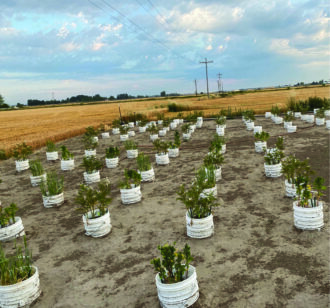When the pale cyst nematode, Globodera pallida, was discovered in southeastern Idaho in 2006, potato exports in Idaho and the United States were severely impacted.
The nematode, which can devastate a potato crop, is a quarantine pest regulated by U.S. Department of Agriculture’s Animal and Plant Health Inspection Service. The Idaho infestation is found within a nine-mile radius and phytosanitary measures to contain the infestation are in place and an eradication program is ongoing. These measures assured the country’s trading partners that the potato crop was safe, and Idaho potatoes are again enjoyed by consumers around the world.
In the quarantine area, potatoes cannot be grown in infested fields, and equipment leaving those fields must be sanitized. Eradication and deregulation of infested fields is the ultimate goal, and University of Idaho researchers, including graduate students Paige Hickman, Lindsay Schulz and Bhupendra Bhatta are at the forefront of research to find and develop strategies in support of the eradication efforts.
“Potato cysts nematodes are found in soil and easily transported on any equipment or plant material that may contain infested soil. Cysts, formed on potato roots of susceptible varieties, are full of hundreds of eggs” explained Hickman, a sixth-year PhD candidate.
“And the encysted eggs can persist in soil in the absence of a host for 20 or more years.”
As with most nematodes, the best current option for control is either avoidance or the application of nematicides, including fumigants. But those chemical inputs are expensive and can account for about 20 percent of growers’ total production costs.
Hickman, Schulz and Bhatta are all doctoral students in Dr. Louise-Marie Dandurand’s program and all recently received Western SARE graduate student grants to develop sustainable ways to help eradicate the nematode from infested fields. Hickman’s 2021 grant looked at trap crops and crop rotation.
“With a trap crop, you need a nonhost crop that will make the nematode hatch but not allow it to develop or reproduce,” she explained. “So it’ll hatch out and die. Litchi tomato is very good at this, and there is some evidence that quinoa also causes some hatch, so my project looked at both of those.”
Working with strict quarantine and sanitation protocols, Hickman found litchi tomato, a member of the Solanaceae family, is highly effective, reducing the nematode more than 90 percent in rotation with potato. Quinoa was found to reduce the nematode by 30 to 40 percent but still may be a good option for growers with infested fields since it is a commercial crop whereas litchi tomato is not.
In 2023, Schulz received a Western SARE grant that builds on the earlier project – identifying specifically what in litchi tomato is toxic to the nematode as a first step in synthesizing it into a potential nematicide.
“What I’ve been doing is growing litchi tomato to 8-weeks-old, just about at the flowering stage, then freeze-drying it and grinding it up,” explained Schulz, who is now in her fourth year in the program. “I separate the stems and the leaves from the root tissue, then extract it with different solvents to see which compounds within these plant tissues is most toxic to the nematode.”
The analysis is ongoing but could one day result in a product growers could apply to affected fields that kills the pale cyst nematode and is far less environmentally toxic than fumigants being applied currently.
The latest of the PhD students to receive a Western SARE grant, Bhatta, is looking at biofumigation with seed meal extract of a glucosinolate-containing mustard in the Brassica family. His research is just getting started.
Dandurand said other research is ongoing to develop potato varieties with resistance to G. pallida. The ultimate solution, she believes, will be an integrated, all-the-above approach.
“We’re working toward a successful cropping system rather than just a single solution because I don’t think there is just one solution,” she said. “Obviously, resistant varieties will play a large role, but I think it’s important to have a package that likely includes nematicides. You can’t just have one control measure and expect it to always work.”
And the idea that her students may help create that cropping system, with Western SARE grants?
“I think my students are really good writers,” Dandurand said. “They have good ideas and put very nice packages together. And the Western SARE grad student grants give them a good sense of what grants are all about.”
